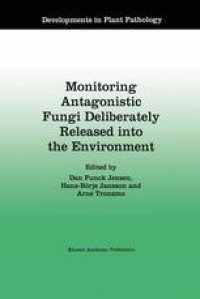
Ebook: Monitoring Antagonistic Fungi Deliberately Released into the Environment
- Tags: Plant Pathology, Plant Sciences
- Series: Developments in Plant Pathology 8
- Year: 1996
- Publisher: Springer Netherlands
- Edition: 1
- Language: English
- pdf
Microorganisms, including those genetically modified (GMOs), are increasingly being released deliberately into the environment for different purposes. One major interest is the use of antagonistic organisms for biological control of pests and plant diseases. Both in the development of biocontrol agents and their later risk assessment and product approval, there is a need for methods that facilitate monitoring of such introduced microorganisms. This book particularly addresses the various approaches for monitoring introduced fungi and the current status of techniques which may be relevant to use are described. Such techniques include marker genes and other DNA-based techniques, serology using polyclonals or monoclonals, the use of enzymes or secondary metabolite profiles, and `electronic noses' as well as more traditional methods like dilution plating.
Microorganisms, including those genetically modified (GMOs), are increasingly being released deliberately into the environment for different purposes. One major interest is the use of antagonistic organisms for biological control of pests and plant diseases. Both in the development of biocontrol agents and their later risk assessment and product approval, there is a need for methods that facilitate monitoring of such introduced microorganisms. This book particularly addresses the various approaches for monitoring introduced fungi and the current status of techniques which may be relevant to use are described. Such techniques include marker genes and other DNA-based techniques, serology using polyclonals or monoclonals, the use of enzymes or secondary metabolite profiles, and `electronic noses' as well as more traditional methods like dilution plating.
Microorganisms, including those genetically modified (GMOs), are increasingly being released deliberately into the environment for different purposes. One major interest is the use of antagonistic organisms for biological control of pests and plant diseases. Both in the development of biocontrol agents and their later risk assessment and product approval, there is a need for methods that facilitate monitoring of such introduced microorganisms. This book particularly addresses the various approaches for monitoring introduced fungi and the current status of techniques which may be relevant to use are described. Such techniques include marker genes and other DNA-based techniques, serology using polyclonals or monoclonals, the use of enzymes or secondary metabolite profiles, and `electronic noses' as well as more traditional methods like dilution plating.
Content:
Front Matter....Pages i-xv
Monitoring of Antagonistic Fungi. Perspectives, Needs and Legislation....Pages 1-9
Some Aspects of Fungal Ecology....Pages 11-16
Quantification of Fungal Growth in the Environment....Pages 17-24
Occurrence of Gliocladium Roseum on Barley Roots in Sand and Field Soil....Pages 25-31
Use of a Metalaxyl Tolerant Pythium Oligandrum Isolate for Selectively Following Its Population in Soil and Its Colonization of Roots of Diseased and Non-Diseased Plants....Pages 33-37
Recovery and Detection of Deuteromycete Conidia from Soil....Pages 39-48
The Prevalence of Fusarium Solani in Wrinkled and Round-Seeded Pea Genotypes....Pages 49-55
Release of a Cord-Forming Basidiomycete Antagonistic to Heterobasidion Annosum and Its Subsequent Reisolation and Identification....Pages 57-61
Methods to Quantify Nematophagus Fungi in Soil: Microscopy or Gus Gene Activity....Pages 63-70
Monitoring of a Gus Transformed Strain of Trichoderma Harzianum in Soil and Rhizosphere....Pages 71-75
Monitoring growth of Bipolaris sorokiniana in plant tissue using GUS (?-glucuronidase) as a marker....Pages 77-83
Identification of Fungi by Secondary Metabolites....Pages 85-89
Monitoring the Activity of Different Trichoderma Isolates by the Isoelectric Points (pI) of Their Extracellular Enzymes....Pages 91-98
PCR-Based Methods — A Promising Tool for Detection and Identification of Fungi in Soil....Pages 99-104
Identification and Characterization of Isolates of Trichoderma and Gliocladium by PCR-Based Methods....Pages 105-111
Identification of Nematode-Trapping Fungi of the Genus Arthrobotrys Using RFLP Analysis of PCR-Amplified rDNA....Pages 113-121
Cloning and Characterization of Trichoderma Harzianum Genes Induced During Growth on Rhizoctonia Solani Cell Walls....Pages 123-128
Development of Immunoassays for the Detection and Quantification of Fungi....Pages 129-132
Development of Monoclonal Antibody-Based Immunoassays for the Quantification of Rhizoctonia Solani and Trichoderma Harzianum in Soil....Pages 133-137
Group discussion in plenumNon disruptive in situ detection methods....Pages 139-146
Techniques for Monitoring Trichoderma in the Phyllosphere....Pages 147-153
Back Matter....Pages 155-158
....Pages 159-166